Strategic Leadership Development: A Case Study of Clune Fund Services
VerifiedAdded on 2023/06/12
|14
|3709
|453
Case Study
AI Summary
This case study examines the leadership development challenges faced by Clune Fund Services, an Irish-owned organization experiencing rapid growth. The study identifies issues stemming from a lack of leadership training and support for promoted employees, leading to costly errors. It explores alternative leadership development practices such as strategic alignment, tailored competency development, and comprehensive learning approaches. The suitability of outsourcing learning and development practices is also discussed, along with methods for evaluating the effectiveness of leadership development initiatives. The case study recommends a comprehensive learning approach, emphasizing experiential learning to build leadership competencies and address the organization's specific needs, ultimately aiming to create a sustainable leadership pipeline and improve overall business performance. Desklib offers a range of resources including past papers and solved assignments to support students in their studies.
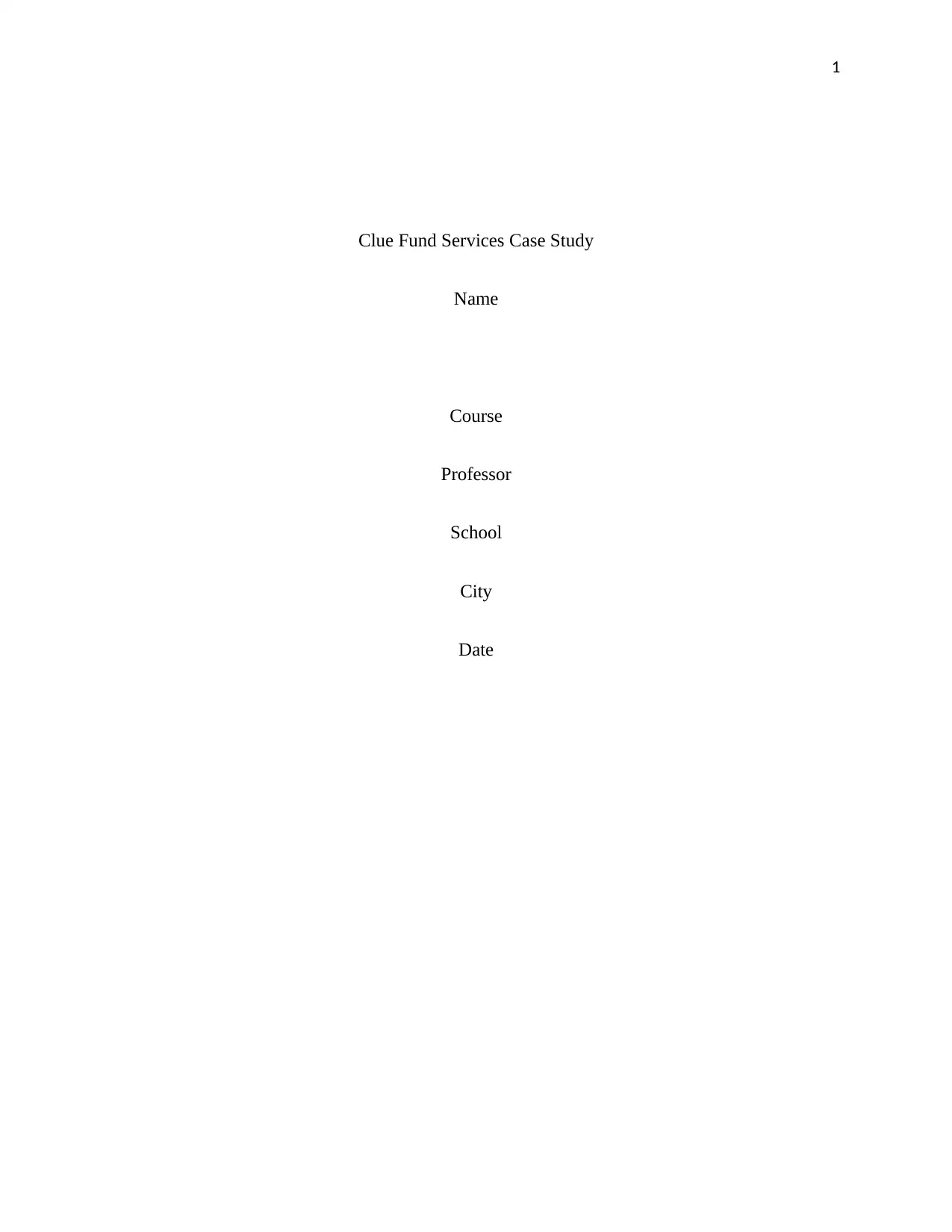
1
Clue Fund Services Case Study
Name
Course
Professor
School
City
Date
Clue Fund Services Case Study
Name
Course
Professor
School
City
Date
Paraphrase This Document
Need a fresh take? Get an instant paraphrase of this document with our AI Paraphraser
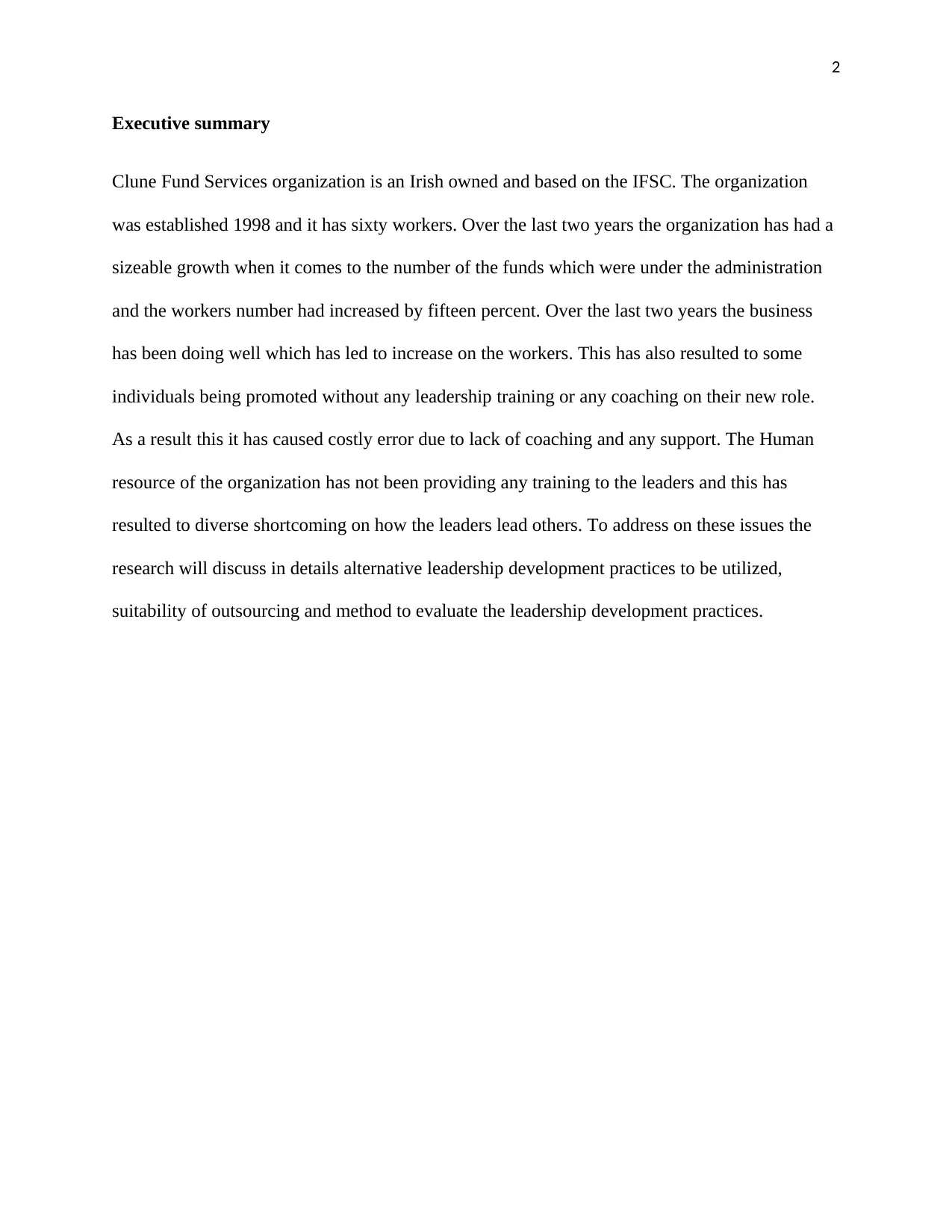
2
Executive summary
Clune Fund Services organization is an Irish owned and based on the IFSC. The organization
was established 1998 and it has sixty workers. Over the last two years the organization has had a
sizeable growth when it comes to the number of the funds which were under the administration
and the workers number had increased by fifteen percent. Over the last two years the business
has been doing well which has led to increase on the workers. This has also resulted to some
individuals being promoted without any leadership training or any coaching on their new role.
As a result this it has caused costly error due to lack of coaching and any support. The Human
resource of the organization has not been providing any training to the leaders and this has
resulted to diverse shortcoming on how the leaders lead others. To address on these issues the
research will discuss in details alternative leadership development practices to be utilized,
suitability of outsourcing and method to evaluate the leadership development practices.
Executive summary
Clune Fund Services organization is an Irish owned and based on the IFSC. The organization
was established 1998 and it has sixty workers. Over the last two years the organization has had a
sizeable growth when it comes to the number of the funds which were under the administration
and the workers number had increased by fifteen percent. Over the last two years the business
has been doing well which has led to increase on the workers. This has also resulted to some
individuals being promoted without any leadership training or any coaching on their new role.
As a result this it has caused costly error due to lack of coaching and any support. The Human
resource of the organization has not been providing any training to the leaders and this has
resulted to diverse shortcoming on how the leaders lead others. To address on these issues the
research will discuss in details alternative leadership development practices to be utilized,
suitability of outsourcing and method to evaluate the leadership development practices.
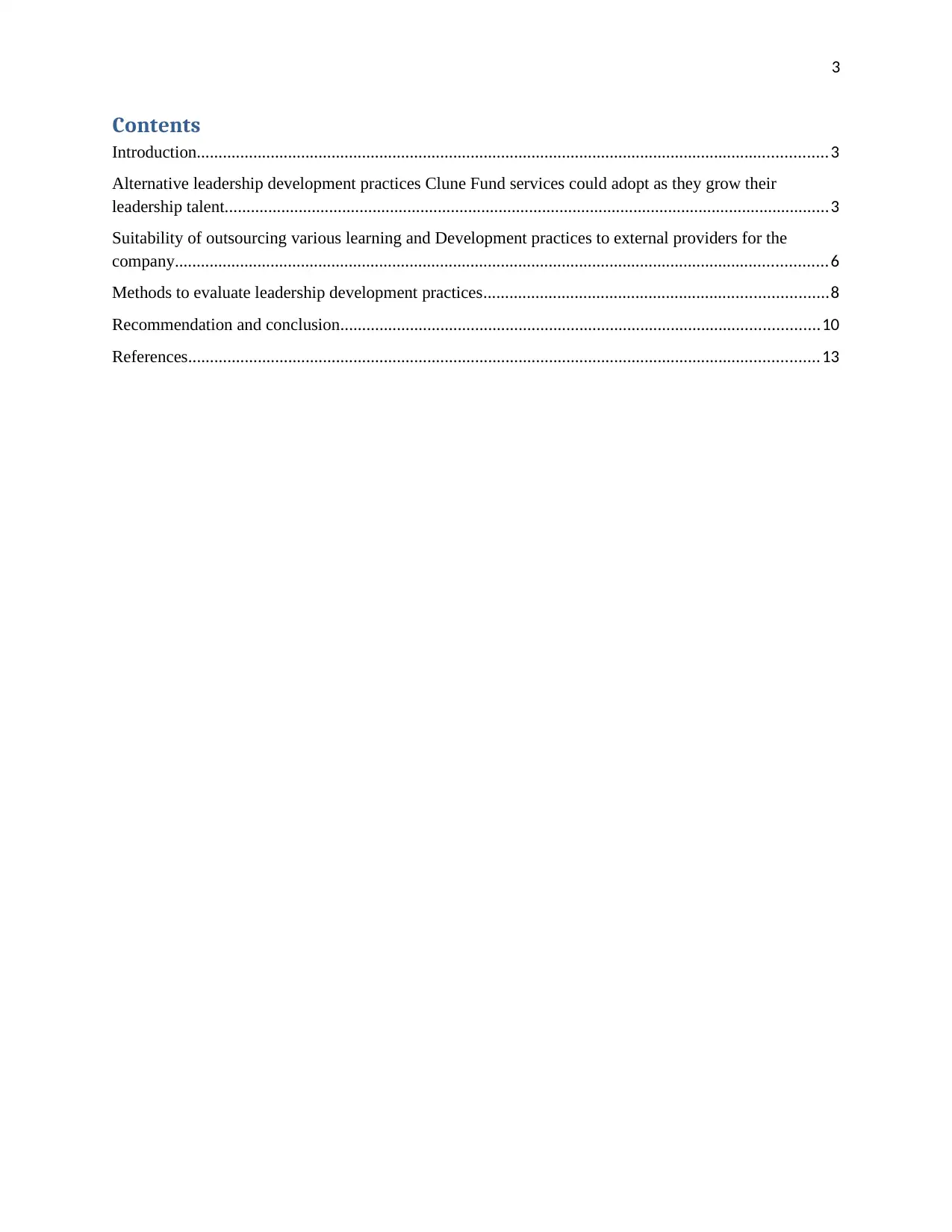
3
Contents
Introduction.................................................................................................................................................3
Alternative leadership development practices Clune Fund services could adopt as they grow their
leadership talent...........................................................................................................................................3
Suitability of outsourcing various learning and Development practices to external providers for the
company......................................................................................................................................................6
Methods to evaluate leadership development practices...............................................................................8
Recommendation and conclusion..............................................................................................................10
References.................................................................................................................................................13
Contents
Introduction.................................................................................................................................................3
Alternative leadership development practices Clune Fund services could adopt as they grow their
leadership talent...........................................................................................................................................3
Suitability of outsourcing various learning and Development practices to external providers for the
company......................................................................................................................................................6
Methods to evaluate leadership development practices...............................................................................8
Recommendation and conclusion..............................................................................................................10
References.................................................................................................................................................13
You're viewing a preview
Unlock full access by subscribing today!
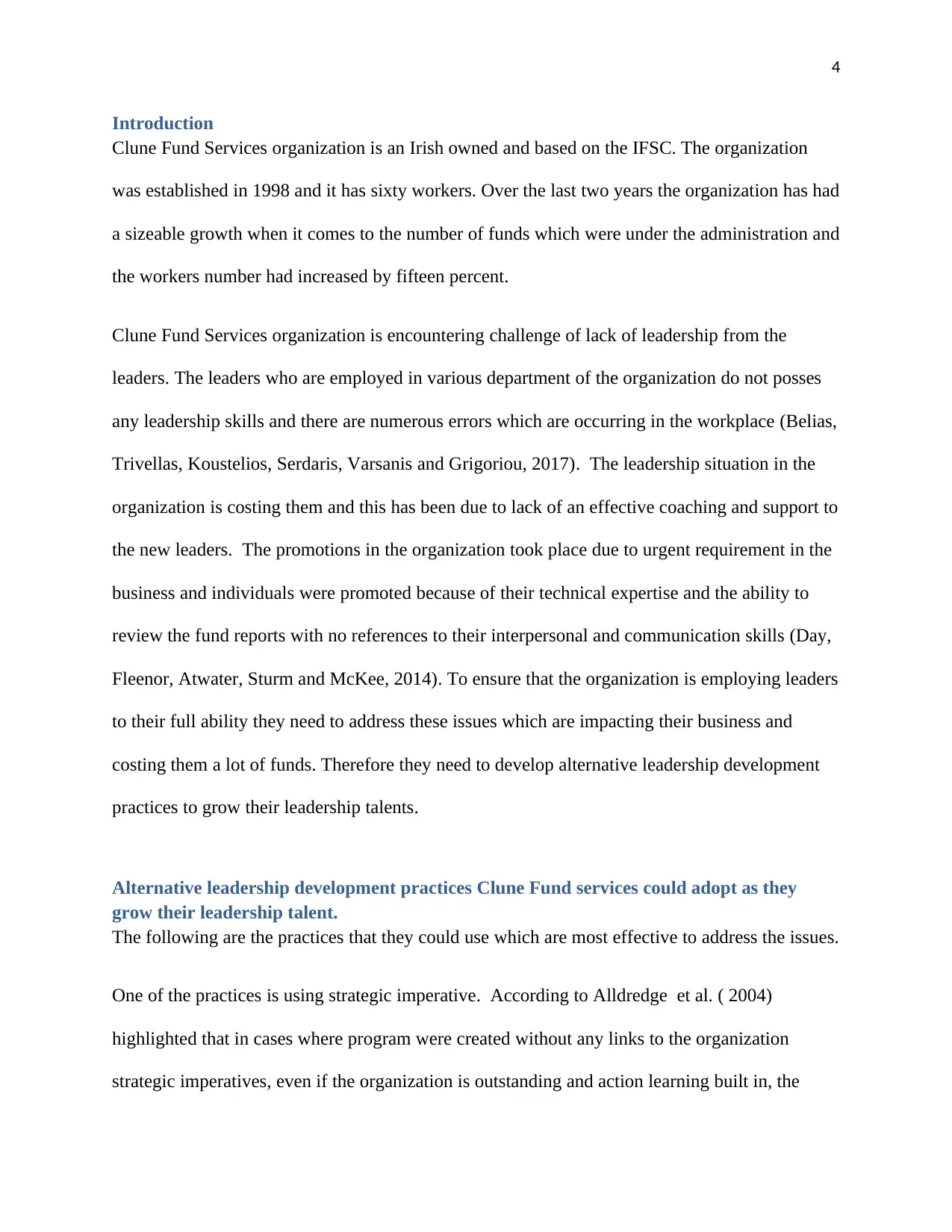
4
Introduction
Clune Fund Services organization is an Irish owned and based on the IFSC. The organization
was established in 1998 and it has sixty workers. Over the last two years the organization has had
a sizeable growth when it comes to the number of funds which were under the administration and
the workers number had increased by fifteen percent.
Clune Fund Services organization is encountering challenge of lack of leadership from the
leaders. The leaders who are employed in various department of the organization do not posses
any leadership skills and there are numerous errors which are occurring in the workplace (Belias,
Trivellas, Koustelios, Serdaris, Varsanis and Grigoriou, 2017). The leadership situation in the
organization is costing them and this has been due to lack of an effective coaching and support to
the new leaders. The promotions in the organization took place due to urgent requirement in the
business and individuals were promoted because of their technical expertise and the ability to
review the fund reports with no references to their interpersonal and communication skills (Day,
Fleenor, Atwater, Sturm and McKee, 2014). To ensure that the organization is employing leaders
to their full ability they need to address these issues which are impacting their business and
costing them a lot of funds. Therefore they need to develop alternative leadership development
practices to grow their leadership talents.
Alternative leadership development practices Clune Fund services could adopt as they
grow their leadership talent.
The following are the practices that they could use which are most effective to address the issues.
One of the practices is using strategic imperative. According to Alldredge et al. ( 2004)
highlighted that in cases where program were created without any links to the organization
strategic imperatives, even if the organization is outstanding and action learning built in, the
Introduction
Clune Fund Services organization is an Irish owned and based on the IFSC. The organization
was established in 1998 and it has sixty workers. Over the last two years the organization has had
a sizeable growth when it comes to the number of funds which were under the administration and
the workers number had increased by fifteen percent.
Clune Fund Services organization is encountering challenge of lack of leadership from the
leaders. The leaders who are employed in various department of the organization do not posses
any leadership skills and there are numerous errors which are occurring in the workplace (Belias,
Trivellas, Koustelios, Serdaris, Varsanis and Grigoriou, 2017). The leadership situation in the
organization is costing them and this has been due to lack of an effective coaching and support to
the new leaders. The promotions in the organization took place due to urgent requirement in the
business and individuals were promoted because of their technical expertise and the ability to
review the fund reports with no references to their interpersonal and communication skills (Day,
Fleenor, Atwater, Sturm and McKee, 2014). To ensure that the organization is employing leaders
to their full ability they need to address these issues which are impacting their business and
costing them a lot of funds. Therefore they need to develop alternative leadership development
practices to grow their leadership talents.
Alternative leadership development practices Clune Fund services could adopt as they
grow their leadership talent.
The following are the practices that they could use which are most effective to address the issues.
One of the practices is using strategic imperative. According to Alldredge et al. ( 2004)
highlighted that in cases where program were created without any links to the organization
strategic imperatives, even if the organization is outstanding and action learning built in, the
Paraphrase This Document
Need a fresh take? Get an instant paraphrase of this document with our AI Paraphraser
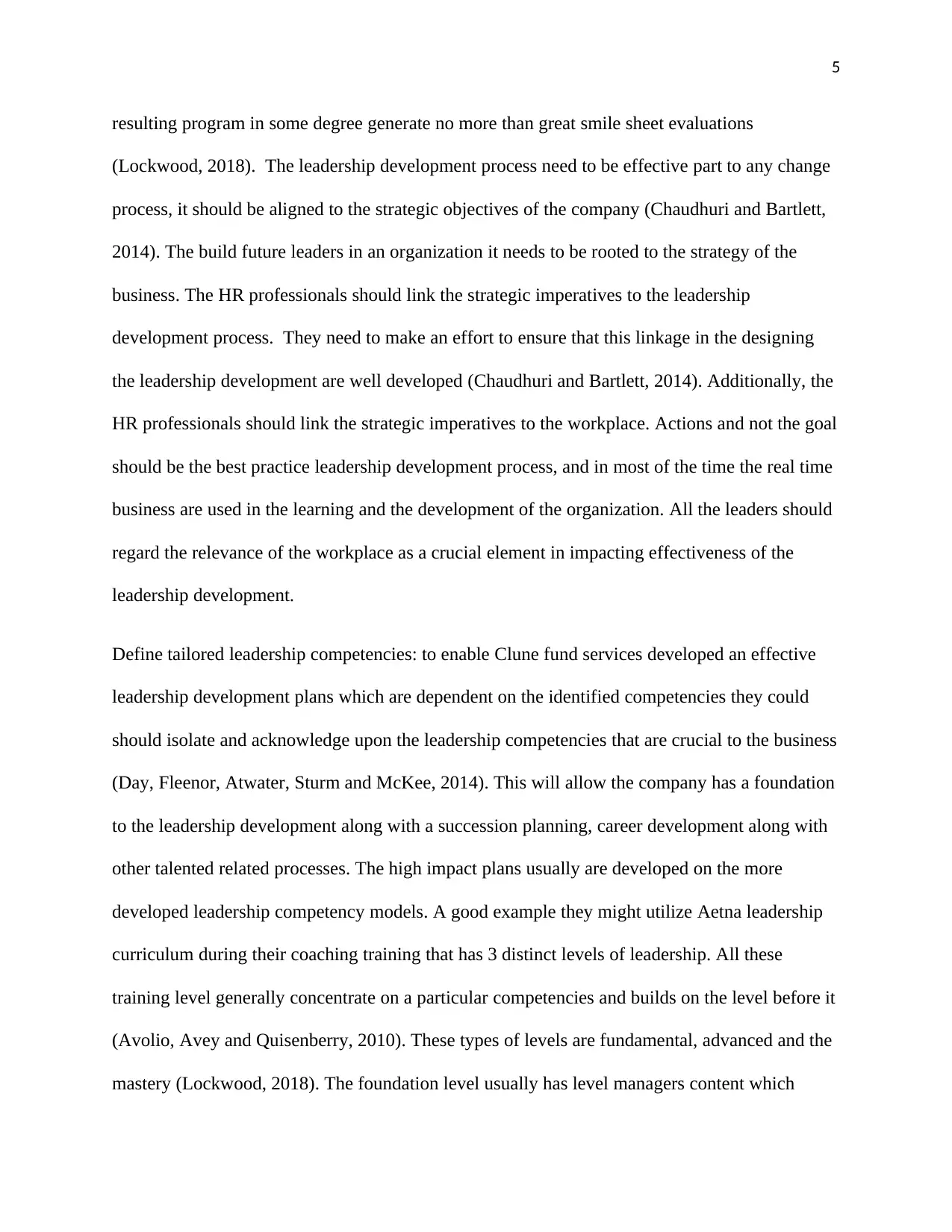
5
resulting program in some degree generate no more than great smile sheet evaluations
(Lockwood, 2018). The leadership development process need to be effective part to any change
process, it should be aligned to the strategic objectives of the company (Chaudhuri and Bartlett,
2014). The build future leaders in an organization it needs to be rooted to the strategy of the
business. The HR professionals should link the strategic imperatives to the leadership
development process. They need to make an effort to ensure that this linkage in the designing
the leadership development are well developed (Chaudhuri and Bartlett, 2014). Additionally, the
HR professionals should link the strategic imperatives to the workplace. Actions and not the goal
should be the best practice leadership development process, and in most of the time the real time
business are used in the learning and the development of the organization. All the leaders should
regard the relevance of the workplace as a crucial element in impacting effectiveness of the
leadership development.
Define tailored leadership competencies: to enable Clune fund services developed an effective
leadership development plans which are dependent on the identified competencies they could
should isolate and acknowledge upon the leadership competencies that are crucial to the business
(Day, Fleenor, Atwater, Sturm and McKee, 2014). This will allow the company has a foundation
to the leadership development along with a succession planning, career development along with
other talented related processes. The high impact plans usually are developed on the more
developed leadership competency models. A good example they might utilize Aetna leadership
curriculum during their coaching training that has 3 distinct levels of leadership. All these
training level generally concentrate on a particular competencies and builds on the level before it
(Avolio, Avey and Quisenberry, 2010). These types of levels are fundamental, advanced and the
mastery (Lockwood, 2018). The foundation level usually has level managers content which
resulting program in some degree generate no more than great smile sheet evaluations
(Lockwood, 2018). The leadership development process need to be effective part to any change
process, it should be aligned to the strategic objectives of the company (Chaudhuri and Bartlett,
2014). The build future leaders in an organization it needs to be rooted to the strategy of the
business. The HR professionals should link the strategic imperatives to the leadership
development process. They need to make an effort to ensure that this linkage in the designing
the leadership development are well developed (Chaudhuri and Bartlett, 2014). Additionally, the
HR professionals should link the strategic imperatives to the workplace. Actions and not the goal
should be the best practice leadership development process, and in most of the time the real time
business are used in the learning and the development of the organization. All the leaders should
regard the relevance of the workplace as a crucial element in impacting effectiveness of the
leadership development.
Define tailored leadership competencies: to enable Clune fund services developed an effective
leadership development plans which are dependent on the identified competencies they could
should isolate and acknowledge upon the leadership competencies that are crucial to the business
(Day, Fleenor, Atwater, Sturm and McKee, 2014). This will allow the company has a foundation
to the leadership development along with a succession planning, career development along with
other talented related processes. The high impact plans usually are developed on the more
developed leadership competency models. A good example they might utilize Aetna leadership
curriculum during their coaching training that has 3 distinct levels of leadership. All these
training level generally concentrate on a particular competencies and builds on the level before it
(Avolio, Avey and Quisenberry, 2010). These types of levels are fundamental, advanced and the
mastery (Lockwood, 2018). The foundation level usually has level managers content which
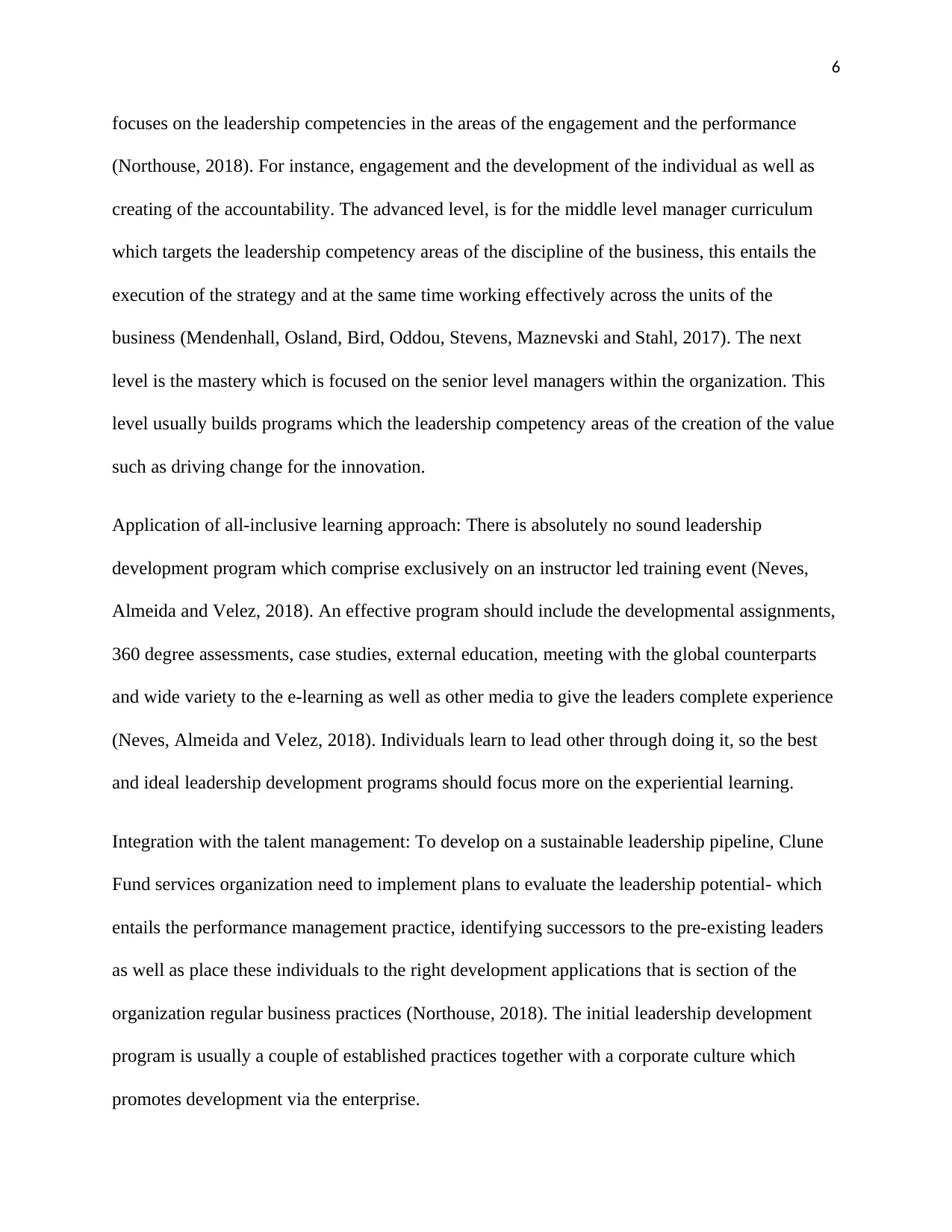
6
focuses on the leadership competencies in the areas of the engagement and the performance
(Northouse, 2018). For instance, engagement and the development of the individual as well as
creating of the accountability. The advanced level, is for the middle level manager curriculum
which targets the leadership competency areas of the discipline of the business, this entails the
execution of the strategy and at the same time working effectively across the units of the
business (Mendenhall, Osland, Bird, Oddou, Stevens, Maznevski and Stahl, 2017). The next
level is the mastery which is focused on the senior level managers within the organization. This
level usually builds programs which the leadership competency areas of the creation of the value
such as driving change for the innovation.
Application of all-inclusive learning approach: There is absolutely no sound leadership
development program which comprise exclusively on an instructor led training event (Neves,
Almeida and Velez, 2018). An effective program should include the developmental assignments,
360 degree assessments, case studies, external education, meeting with the global counterparts
and wide variety to the e-learning as well as other media to give the leaders complete experience
(Neves, Almeida and Velez, 2018). Individuals learn to lead other through doing it, so the best
and ideal leadership development programs should focus more on the experiential learning.
Integration with the talent management: To develop on a sustainable leadership pipeline, Clune
Fund services organization need to implement plans to evaluate the leadership potential- which
entails the performance management practice, identifying successors to the pre-existing leaders
as well as place these individuals to the right development applications that is section of the
organization regular business practices (Northouse, 2018). The initial leadership development
program is usually a couple of established practices together with a corporate culture which
promotes development via the enterprise.
focuses on the leadership competencies in the areas of the engagement and the performance
(Northouse, 2018). For instance, engagement and the development of the individual as well as
creating of the accountability. The advanced level, is for the middle level manager curriculum
which targets the leadership competency areas of the discipline of the business, this entails the
execution of the strategy and at the same time working effectively across the units of the
business (Mendenhall, Osland, Bird, Oddou, Stevens, Maznevski and Stahl, 2017). The next
level is the mastery which is focused on the senior level managers within the organization. This
level usually builds programs which the leadership competency areas of the creation of the value
such as driving change for the innovation.
Application of all-inclusive learning approach: There is absolutely no sound leadership
development program which comprise exclusively on an instructor led training event (Neves,
Almeida and Velez, 2018). An effective program should include the developmental assignments,
360 degree assessments, case studies, external education, meeting with the global counterparts
and wide variety to the e-learning as well as other media to give the leaders complete experience
(Neves, Almeida and Velez, 2018). Individuals learn to lead other through doing it, so the best
and ideal leadership development programs should focus more on the experiential learning.
Integration with the talent management: To develop on a sustainable leadership pipeline, Clune
Fund services organization need to implement plans to evaluate the leadership potential- which
entails the performance management practice, identifying successors to the pre-existing leaders
as well as place these individuals to the right development applications that is section of the
organization regular business practices (Northouse, 2018). The initial leadership development
program is usually a couple of established practices together with a corporate culture which
promotes development via the enterprise.
You're viewing a preview
Unlock full access by subscribing today!
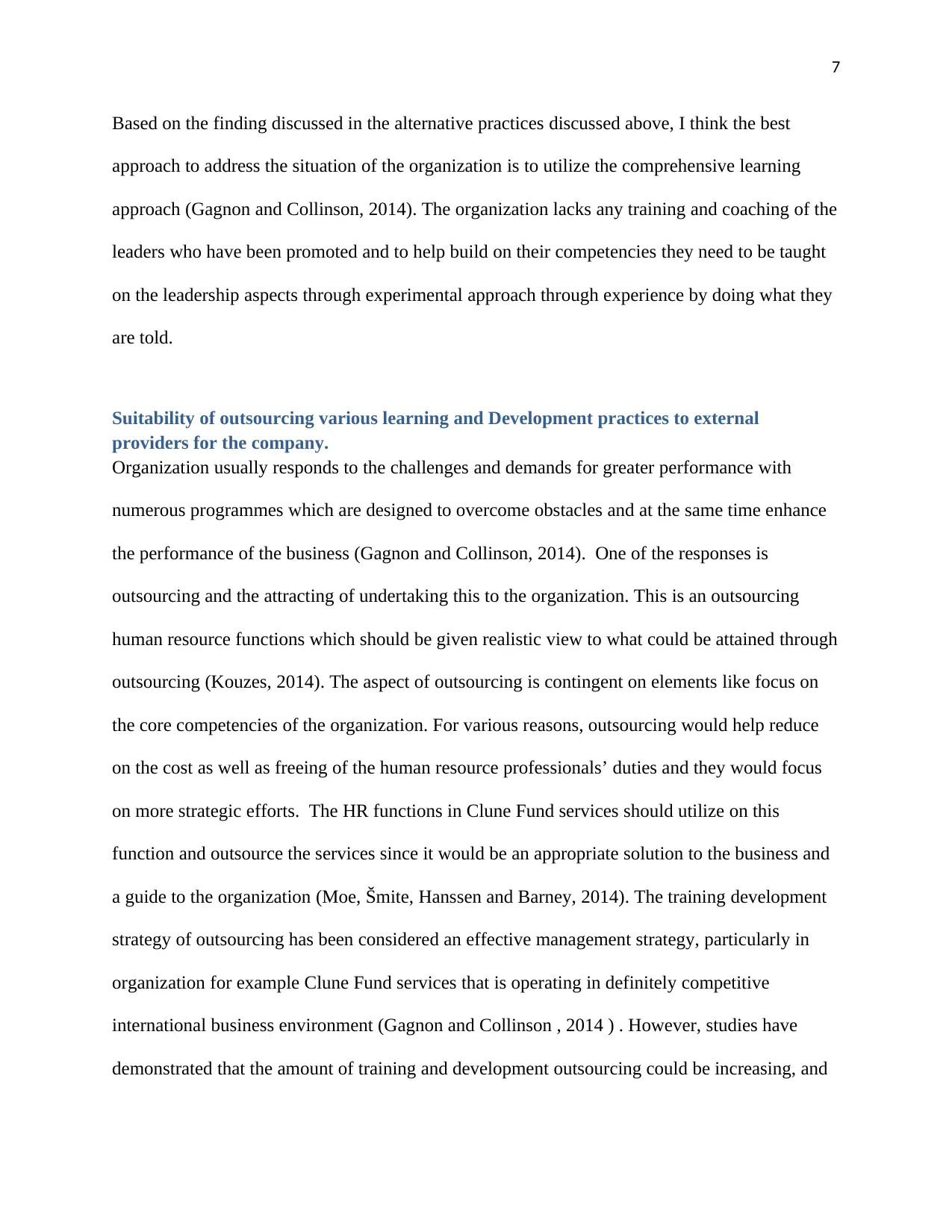
7
Based on the finding discussed in the alternative practices discussed above, I think the best
approach to address the situation of the organization is to utilize the comprehensive learning
approach (Gagnon and Collinson, 2014). The organization lacks any training and coaching of the
leaders who have been promoted and to help build on their competencies they need to be taught
on the leadership aspects through experimental approach through experience by doing what they
are told.
Suitability of outsourcing various learning and Development practices to external
providers for the company.
Organization usually responds to the challenges and demands for greater performance with
numerous programmes which are designed to overcome obstacles and at the same time enhance
the performance of the business (Gagnon and Collinson, 2014). One of the responses is
outsourcing and the attracting of undertaking this to the organization. This is an outsourcing
human resource functions which should be given realistic view to what could be attained through
outsourcing (Kouzes, 2014). The aspect of outsourcing is contingent on elements like focus on
the core competencies of the organization. For various reasons, outsourcing would help reduce
on the cost as well as freeing of the human resource professionals’ duties and they would focus
on more strategic efforts. The HR functions in Clune Fund services should utilize on this
function and outsource the services since it would be an appropriate solution to the business and
a guide to the organization (Moe, Šmite, Hanssen and Barney, 2014). The training development
strategy of outsourcing has been considered an effective management strategy, particularly in
organization for example Clune Fund services that is operating in definitely competitive
international business environment (Gagnon and Collinson , 2014 ) . However, studies have
demonstrated that the amount of training and development outsourcing could be increasing, and
Based on the finding discussed in the alternative practices discussed above, I think the best
approach to address the situation of the organization is to utilize the comprehensive learning
approach (Gagnon and Collinson, 2014). The organization lacks any training and coaching of the
leaders who have been promoted and to help build on their competencies they need to be taught
on the leadership aspects through experimental approach through experience by doing what they
are told.
Suitability of outsourcing various learning and Development practices to external
providers for the company.
Organization usually responds to the challenges and demands for greater performance with
numerous programmes which are designed to overcome obstacles and at the same time enhance
the performance of the business (Gagnon and Collinson, 2014). One of the responses is
outsourcing and the attracting of undertaking this to the organization. This is an outsourcing
human resource functions which should be given realistic view to what could be attained through
outsourcing (Kouzes, 2014). The aspect of outsourcing is contingent on elements like focus on
the core competencies of the organization. For various reasons, outsourcing would help reduce
on the cost as well as freeing of the human resource professionals’ duties and they would focus
on more strategic efforts. The HR functions in Clune Fund services should utilize on this
function and outsource the services since it would be an appropriate solution to the business and
a guide to the organization (Moe, Šmite, Hanssen and Barney, 2014). The training development
strategy of outsourcing has been considered an effective management strategy, particularly in
organization for example Clune Fund services that is operating in definitely competitive
international business environment (Gagnon and Collinson , 2014 ) . However, studies have
demonstrated that the amount of training and development outsourcing could be increasing, and
Paraphrase This Document
Need a fresh take? Get an instant paraphrase of this document with our AI Paraphraser
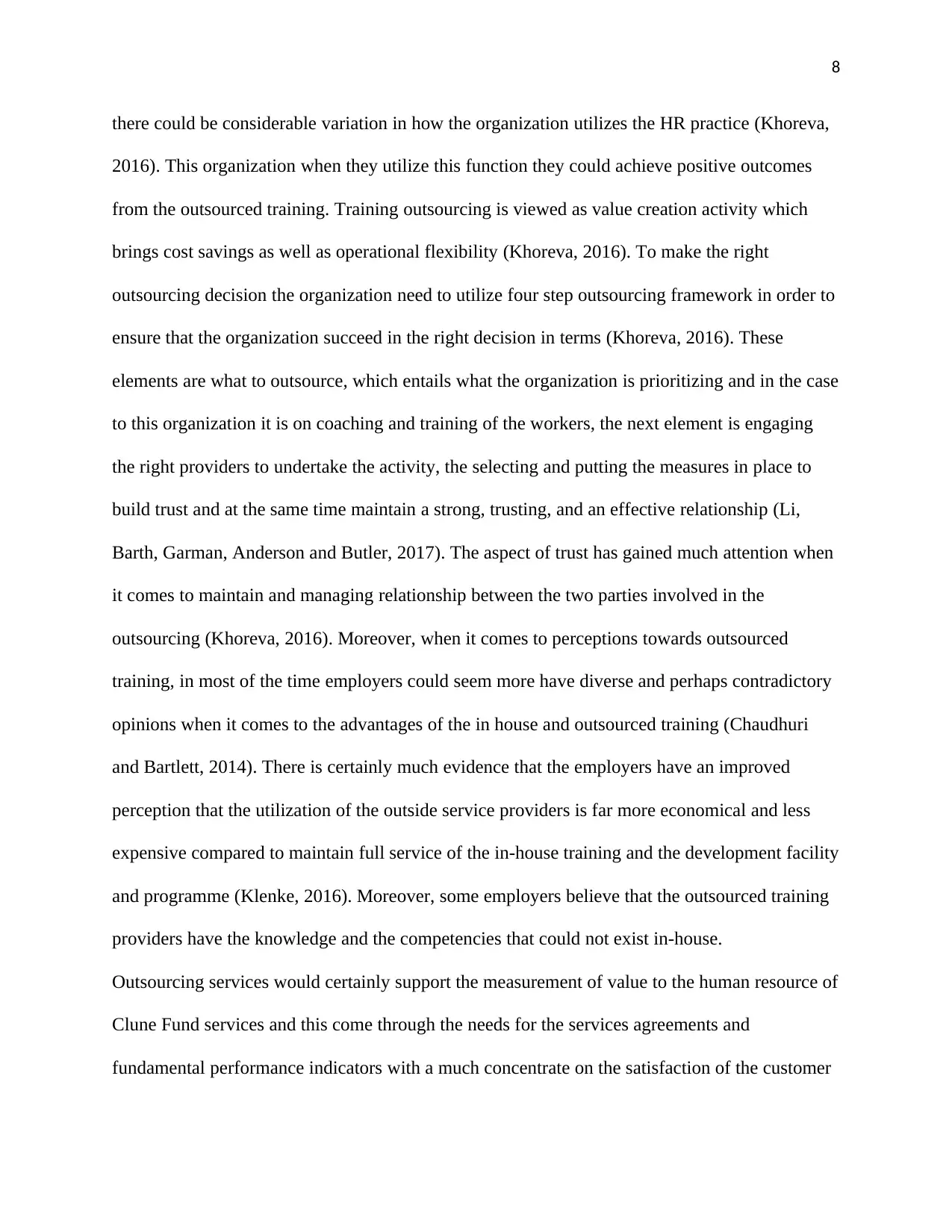
8
there could be considerable variation in how the organization utilizes the HR practice (Khoreva,
2016). This organization when they utilize this function they could achieve positive outcomes
from the outsourced training. Training outsourcing is viewed as value creation activity which
brings cost savings as well as operational flexibility (Khoreva, 2016). To make the right
outsourcing decision the organization need to utilize four step outsourcing framework in order to
ensure that the organization succeed in the right decision in terms (Khoreva, 2016). These
elements are what to outsource, which entails what the organization is prioritizing and in the case
to this organization it is on coaching and training of the workers, the next element is engaging
the right providers to undertake the activity, the selecting and putting the measures in place to
build trust and at the same time maintain a strong, trusting, and an effective relationship (Li,
Barth, Garman, Anderson and Butler, 2017). The aspect of trust has gained much attention when
it comes to maintain and managing relationship between the two parties involved in the
outsourcing (Khoreva, 2016). Moreover, when it comes to perceptions towards outsourced
training, in most of the time employers could seem more have diverse and perhaps contradictory
opinions when it comes to the advantages of the in house and outsourced training (Chaudhuri
and Bartlett, 2014). There is certainly much evidence that the employers have an improved
perception that the utilization of the outside service providers is far more economical and less
expensive compared to maintain full service of the in-house training and the development facility
and programme (Klenke, 2016). Moreover, some employers believe that the outsourced training
providers have the knowledge and the competencies that could not exist in-house.
Outsourcing services would certainly support the measurement of value to the human resource of
Clune Fund services and this come through the needs for the services agreements and
fundamental performance indicators with a much concentrate on the satisfaction of the customer
there could be considerable variation in how the organization utilizes the HR practice (Khoreva,
2016). This organization when they utilize this function they could achieve positive outcomes
from the outsourced training. Training outsourcing is viewed as value creation activity which
brings cost savings as well as operational flexibility (Khoreva, 2016). To make the right
outsourcing decision the organization need to utilize four step outsourcing framework in order to
ensure that the organization succeed in the right decision in terms (Khoreva, 2016). These
elements are what to outsource, which entails what the organization is prioritizing and in the case
to this organization it is on coaching and training of the workers, the next element is engaging
the right providers to undertake the activity, the selecting and putting the measures in place to
build trust and at the same time maintain a strong, trusting, and an effective relationship (Li,
Barth, Garman, Anderson and Butler, 2017). The aspect of trust has gained much attention when
it comes to maintain and managing relationship between the two parties involved in the
outsourcing (Khoreva, 2016). Moreover, when it comes to perceptions towards outsourced
training, in most of the time employers could seem more have diverse and perhaps contradictory
opinions when it comes to the advantages of the in house and outsourced training (Chaudhuri
and Bartlett, 2014). There is certainly much evidence that the employers have an improved
perception that the utilization of the outside service providers is far more economical and less
expensive compared to maintain full service of the in-house training and the development facility
and programme (Klenke, 2016). Moreover, some employers believe that the outsourced training
providers have the knowledge and the competencies that could not exist in-house.
Outsourcing services would certainly support the measurement of value to the human resource of
Clune Fund services and this come through the needs for the services agreements and
fundamental performance indicators with a much concentrate on the satisfaction of the customer
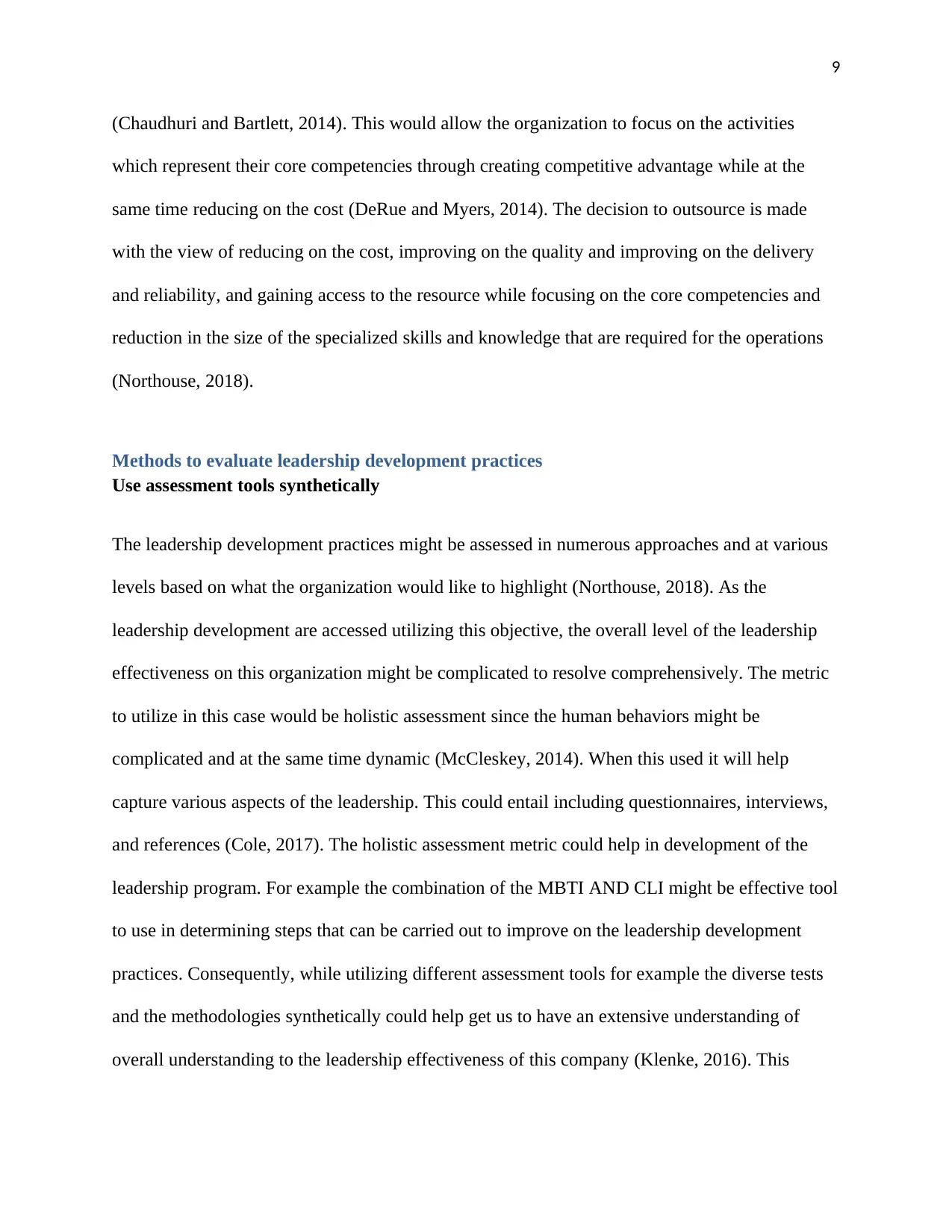
9
(Chaudhuri and Bartlett, 2014). This would allow the organization to focus on the activities
which represent their core competencies through creating competitive advantage while at the
same time reducing on the cost (DeRue and Myers, 2014). The decision to outsource is made
with the view of reducing on the cost, improving on the quality and improving on the delivery
and reliability, and gaining access to the resource while focusing on the core competencies and
reduction in the size of the specialized skills and knowledge that are required for the operations
(Northouse, 2018).
Methods to evaluate leadership development practices
Use assessment tools synthetically
The leadership development practices might be assessed in numerous approaches and at various
levels based on what the organization would like to highlight (Northouse, 2018). As the
leadership development are accessed utilizing this objective, the overall level of the leadership
effectiveness on this organization might be complicated to resolve comprehensively. The metric
to utilize in this case would be holistic assessment since the human behaviors might be
complicated and at the same time dynamic (McCleskey, 2014). When this used it will help
capture various aspects of the leadership. This could entail including questionnaires, interviews,
and references (Cole, 2017). The holistic assessment metric could help in development of the
leadership program. For example the combination of the MBTI AND CLI might be effective tool
to use in determining steps that can be carried out to improve on the leadership development
practices. Consequently, while utilizing different assessment tools for example the diverse tests
and the methodologies synthetically could help get us to have an extensive understanding of
overall understanding to the leadership effectiveness of this company (Klenke, 2016). This
(Chaudhuri and Bartlett, 2014). This would allow the organization to focus on the activities
which represent their core competencies through creating competitive advantage while at the
same time reducing on the cost (DeRue and Myers, 2014). The decision to outsource is made
with the view of reducing on the cost, improving on the quality and improving on the delivery
and reliability, and gaining access to the resource while focusing on the core competencies and
reduction in the size of the specialized skills and knowledge that are required for the operations
(Northouse, 2018).
Methods to evaluate leadership development practices
Use assessment tools synthetically
The leadership development practices might be assessed in numerous approaches and at various
levels based on what the organization would like to highlight (Northouse, 2018). As the
leadership development are accessed utilizing this objective, the overall level of the leadership
effectiveness on this organization might be complicated to resolve comprehensively. The metric
to utilize in this case would be holistic assessment since the human behaviors might be
complicated and at the same time dynamic (McCleskey, 2014). When this used it will help
capture various aspects of the leadership. This could entail including questionnaires, interviews,
and references (Cole, 2017). The holistic assessment metric could help in development of the
leadership program. For example the combination of the MBTI AND CLI might be effective tool
to use in determining steps that can be carried out to improve on the leadership development
practices. Consequently, while utilizing different assessment tools for example the diverse tests
and the methodologies synthetically could help get us to have an extensive understanding of
overall understanding to the leadership effectiveness of this company (Klenke, 2016). This
You're viewing a preview
Unlock full access by subscribing today!
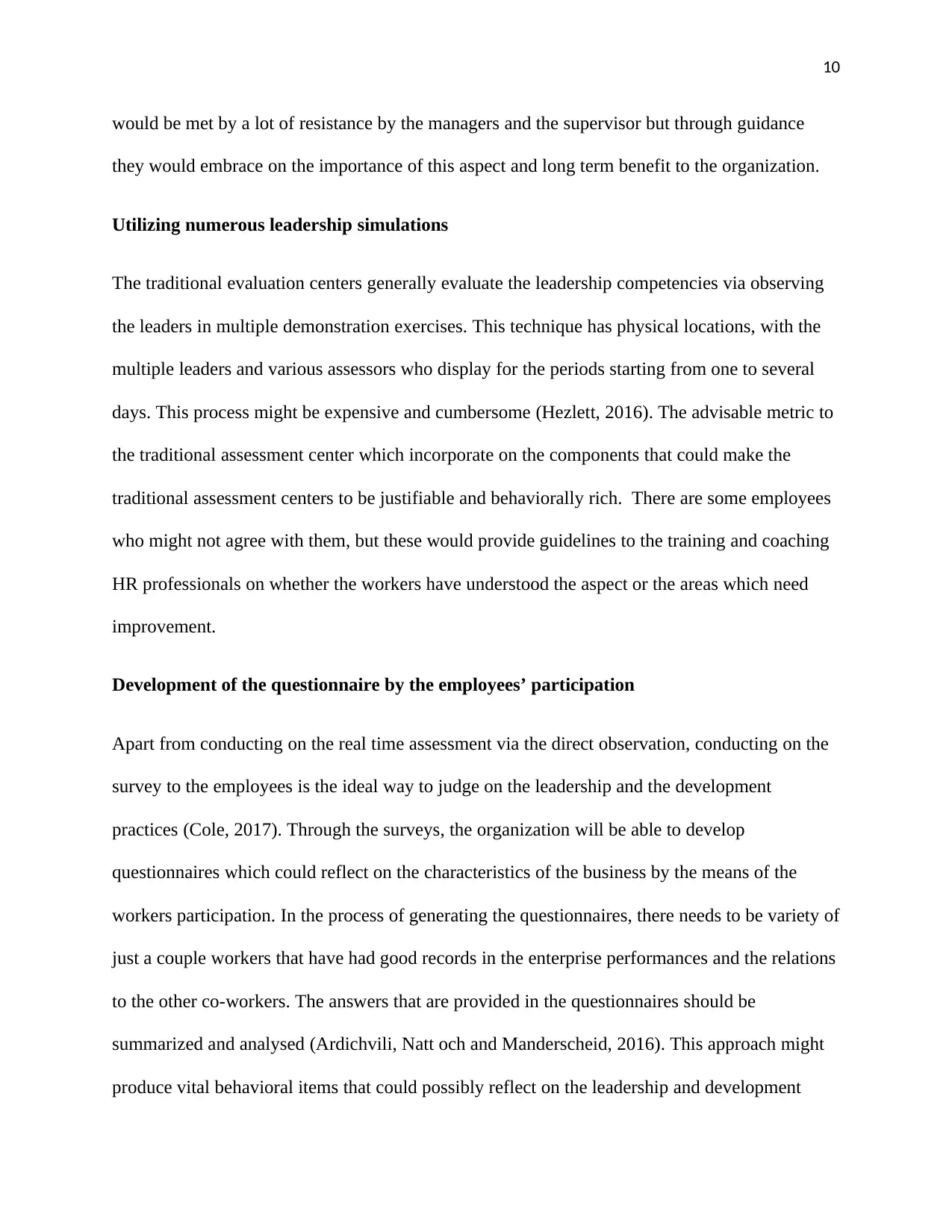
10
would be met by a lot of resistance by the managers and the supervisor but through guidance
they would embrace on the importance of this aspect and long term benefit to the organization.
Utilizing numerous leadership simulations
The traditional evaluation centers generally evaluate the leadership competencies via observing
the leaders in multiple demonstration exercises. This technique has physical locations, with the
multiple leaders and various assessors who display for the periods starting from one to several
days. This process might be expensive and cumbersome (Hezlett, 2016). The advisable metric to
the traditional assessment center which incorporate on the components that could make the
traditional assessment centers to be justifiable and behaviorally rich. There are some employees
who might not agree with them, but these would provide guidelines to the training and coaching
HR professionals on whether the workers have understood the aspect or the areas which need
improvement.
Development of the questionnaire by the employees’ participation
Apart from conducting on the real time assessment via the direct observation, conducting on the
survey to the employees is the ideal way to judge on the leadership and the development
practices (Cole, 2017). Through the surveys, the organization will be able to develop
questionnaires which could reflect on the characteristics of the business by the means of the
workers participation. In the process of generating the questionnaires, there needs to be variety of
just a couple workers that have had good records in the enterprise performances and the relations
to the other co-workers. The answers that are provided in the questionnaires should be
summarized and analysed (Ardichvili, Natt och and Manderscheid, 2016). This approach might
produce vital behavioral items that could possibly reflect on the leadership and development
would be met by a lot of resistance by the managers and the supervisor but through guidance
they would embrace on the importance of this aspect and long term benefit to the organization.
Utilizing numerous leadership simulations
The traditional evaluation centers generally evaluate the leadership competencies via observing
the leaders in multiple demonstration exercises. This technique has physical locations, with the
multiple leaders and various assessors who display for the periods starting from one to several
days. This process might be expensive and cumbersome (Hezlett, 2016). The advisable metric to
the traditional assessment center which incorporate on the components that could make the
traditional assessment centers to be justifiable and behaviorally rich. There are some employees
who might not agree with them, but these would provide guidelines to the training and coaching
HR professionals on whether the workers have understood the aspect or the areas which need
improvement.
Development of the questionnaire by the employees’ participation
Apart from conducting on the real time assessment via the direct observation, conducting on the
survey to the employees is the ideal way to judge on the leadership and the development
practices (Cole, 2017). Through the surveys, the organization will be able to develop
questionnaires which could reflect on the characteristics of the business by the means of the
workers participation. In the process of generating the questionnaires, there needs to be variety of
just a couple workers that have had good records in the enterprise performances and the relations
to the other co-workers. The answers that are provided in the questionnaires should be
summarized and analysed (Ardichvili, Natt och and Manderscheid, 2016). This approach might
produce vital behavioral items that could possibly reflect on the leadership and development
Paraphrase This Document
Need a fresh take? Get an instant paraphrase of this document with our AI Paraphraser
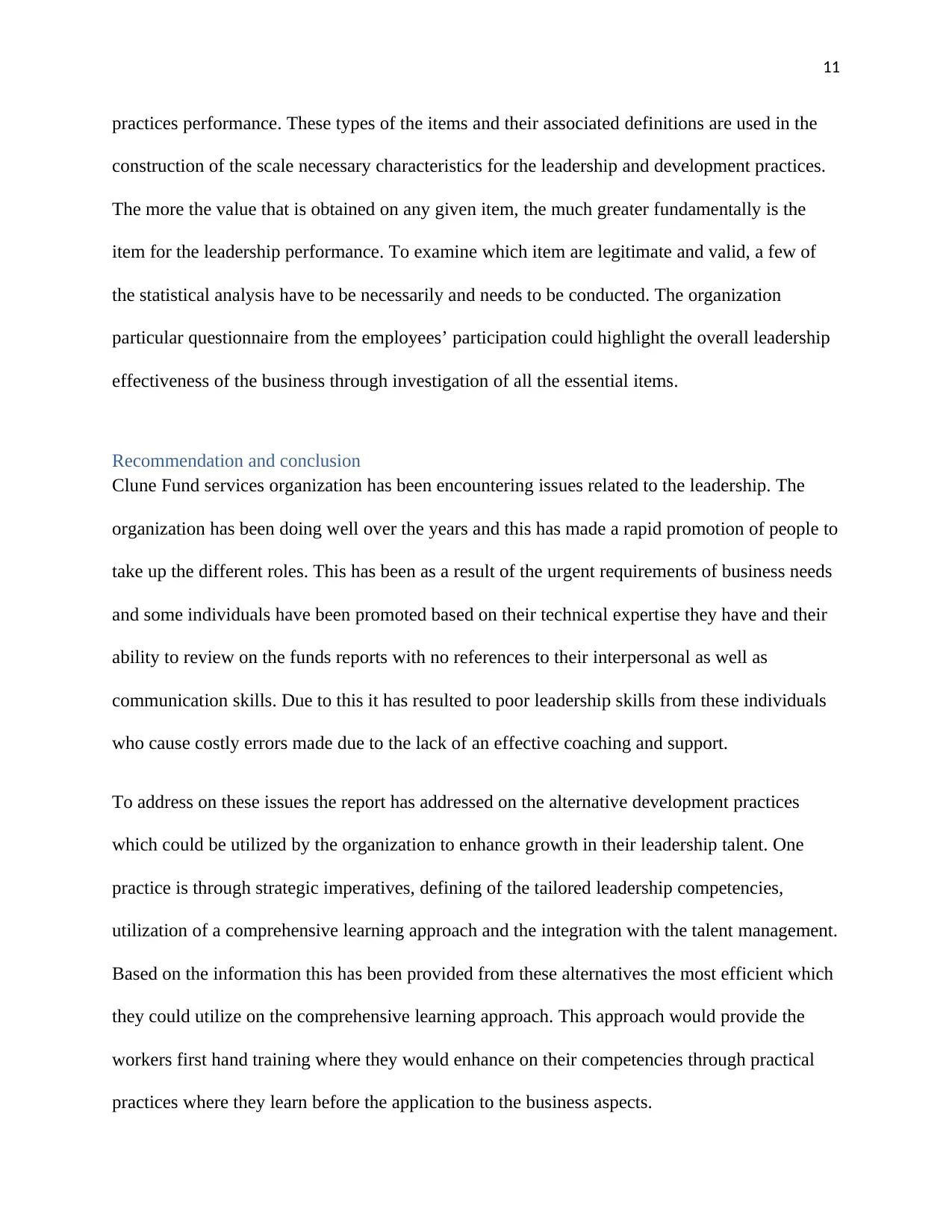
11
practices performance. These types of the items and their associated definitions are used in the
construction of the scale necessary characteristics for the leadership and development practices.
The more the value that is obtained on any given item, the much greater fundamentally is the
item for the leadership performance. To examine which item are legitimate and valid, a few of
the statistical analysis have to be necessarily and needs to be conducted. The organization
particular questionnaire from the employees’ participation could highlight the overall leadership
effectiveness of the business through investigation of all the essential items.
Recommendation and conclusion
Clune Fund services organization has been encountering issues related to the leadership. The
organization has been doing well over the years and this has made a rapid promotion of people to
take up the different roles. This has been as a result of the urgent requirements of business needs
and some individuals have been promoted based on their technical expertise they have and their
ability to review on the funds reports with no references to their interpersonal as well as
communication skills. Due to this it has resulted to poor leadership skills from these individuals
who cause costly errors made due to the lack of an effective coaching and support.
To address on these issues the report has addressed on the alternative development practices
which could be utilized by the organization to enhance growth in their leadership talent. One
practice is through strategic imperatives, defining of the tailored leadership competencies,
utilization of a comprehensive learning approach and the integration with the talent management.
Based on the information this has been provided from these alternatives the most efficient which
they could utilize on the comprehensive learning approach. This approach would provide the
workers first hand training where they would enhance on their competencies through practical
practices where they learn before the application to the business aspects.
practices performance. These types of the items and their associated definitions are used in the
construction of the scale necessary characteristics for the leadership and development practices.
The more the value that is obtained on any given item, the much greater fundamentally is the
item for the leadership performance. To examine which item are legitimate and valid, a few of
the statistical analysis have to be necessarily and needs to be conducted. The organization
particular questionnaire from the employees’ participation could highlight the overall leadership
effectiveness of the business through investigation of all the essential items.
Recommendation and conclusion
Clune Fund services organization has been encountering issues related to the leadership. The
organization has been doing well over the years and this has made a rapid promotion of people to
take up the different roles. This has been as a result of the urgent requirements of business needs
and some individuals have been promoted based on their technical expertise they have and their
ability to review on the funds reports with no references to their interpersonal as well as
communication skills. Due to this it has resulted to poor leadership skills from these individuals
who cause costly errors made due to the lack of an effective coaching and support.
To address on these issues the report has addressed on the alternative development practices
which could be utilized by the organization to enhance growth in their leadership talent. One
practice is through strategic imperatives, defining of the tailored leadership competencies,
utilization of a comprehensive learning approach and the integration with the talent management.
Based on the information this has been provided from these alternatives the most efficient which
they could utilize on the comprehensive learning approach. This approach would provide the
workers first hand training where they would enhance on their competencies through practical
practices where they learn before the application to the business aspects.
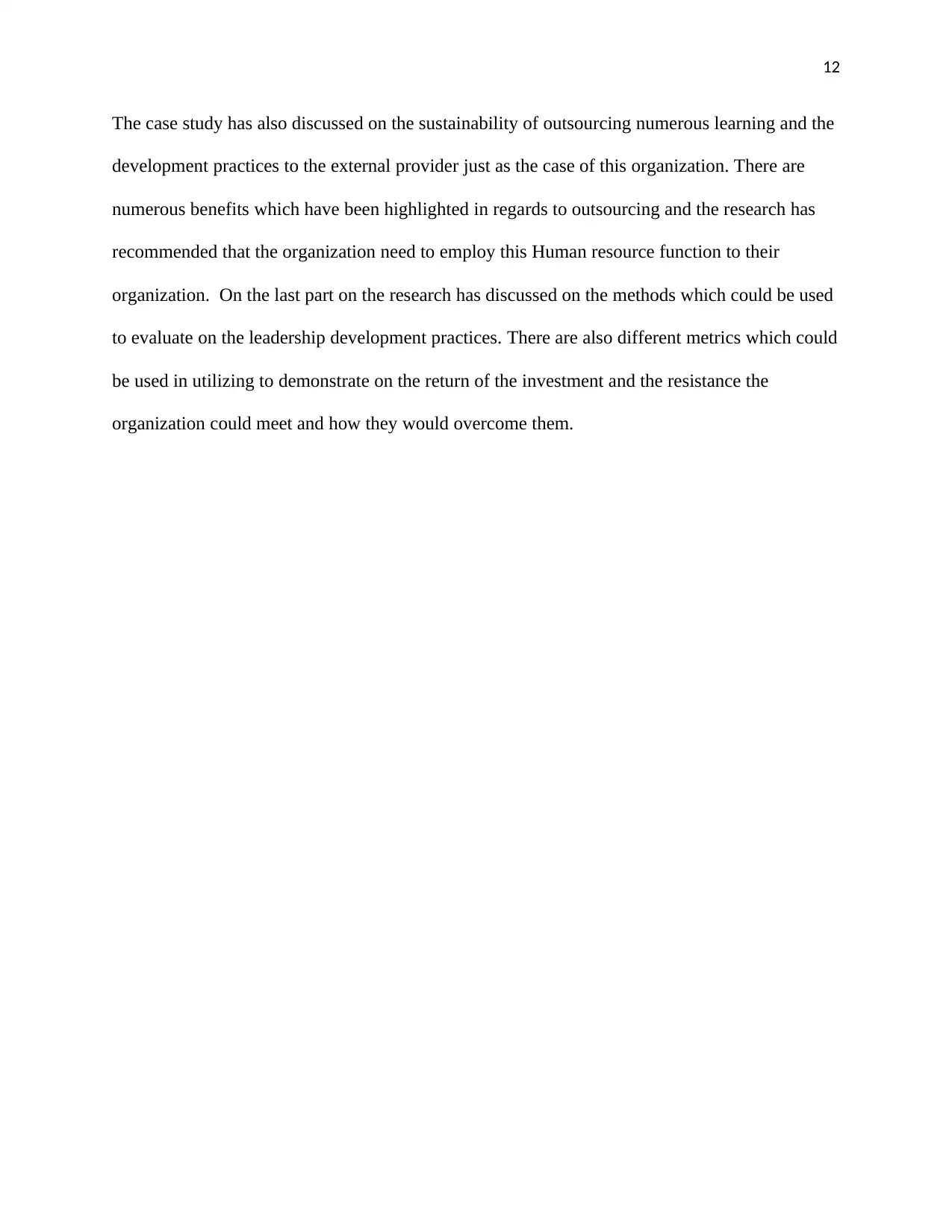
12
The case study has also discussed on the sustainability of outsourcing numerous learning and the
development practices to the external provider just as the case of this organization. There are
numerous benefits which have been highlighted in regards to outsourcing and the research has
recommended that the organization need to employ this Human resource function to their
organization. On the last part on the research has discussed on the methods which could be used
to evaluate on the leadership development practices. There are also different metrics which could
be used in utilizing to demonstrate on the return of the investment and the resistance the
organization could meet and how they would overcome them.
The case study has also discussed on the sustainability of outsourcing numerous learning and the
development practices to the external provider just as the case of this organization. There are
numerous benefits which have been highlighted in regards to outsourcing and the research has
recommended that the organization need to employ this Human resource function to their
organization. On the last part on the research has discussed on the methods which could be used
to evaluate on the leadership development practices. There are also different metrics which could
be used in utilizing to demonstrate on the return of the investment and the resistance the
organization could meet and how they would overcome them.
You're viewing a preview
Unlock full access by subscribing today!
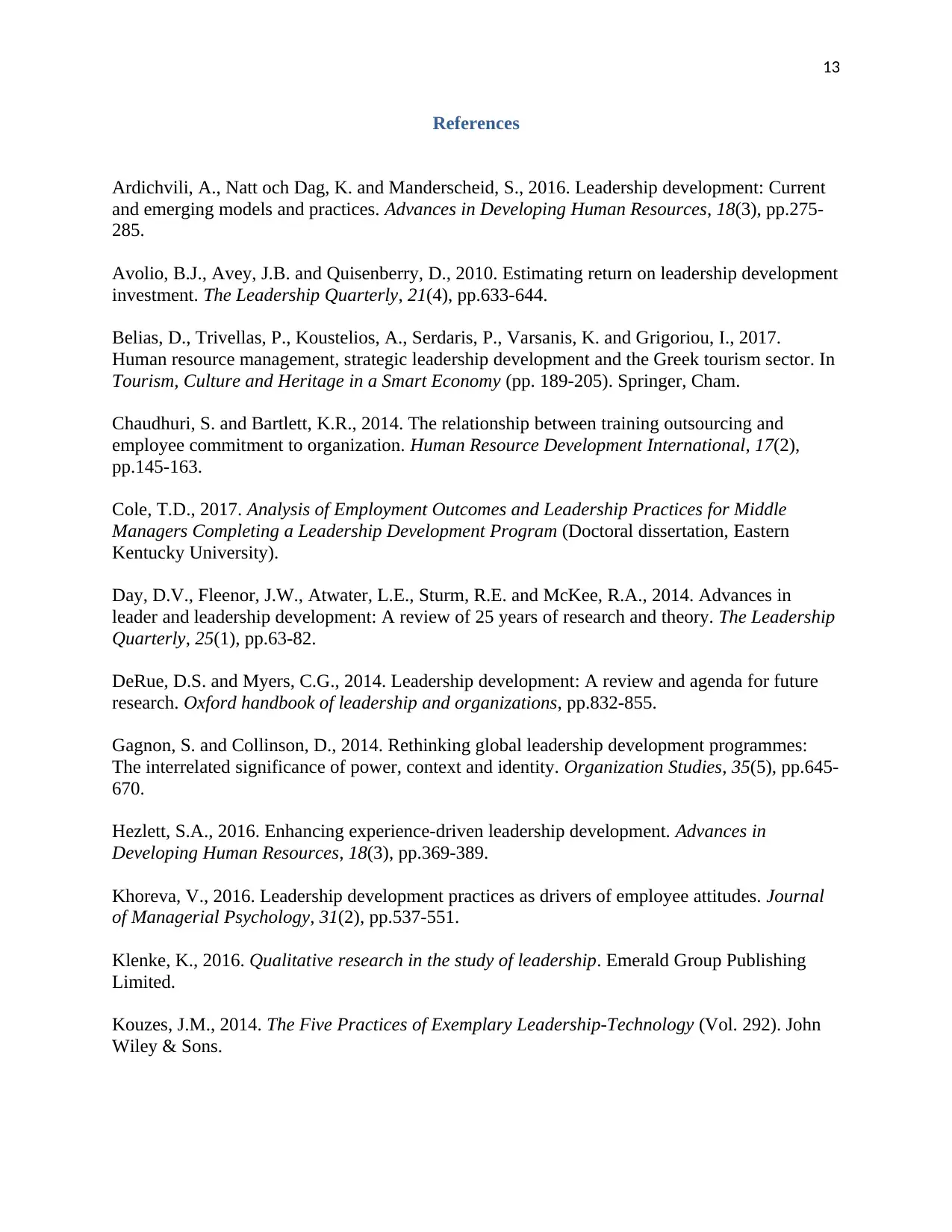
13
References
Ardichvili, A., Natt och Dag, K. and Manderscheid, S., 2016. Leadership development: Current
and emerging models and practices. Advances in Developing Human Resources, 18(3), pp.275-
285.
Avolio, B.J., Avey, J.B. and Quisenberry, D., 2010. Estimating return on leadership development
investment. The Leadership Quarterly, 21(4), pp.633-644.
Belias, D., Trivellas, P., Koustelios, A., Serdaris, P., Varsanis, K. and Grigoriou, I., 2017.
Human resource management, strategic leadership development and the Greek tourism sector. In
Tourism, Culture and Heritage in a Smart Economy (pp. 189-205). Springer, Cham.
Chaudhuri, S. and Bartlett, K.R., 2014. The relationship between training outsourcing and
employee commitment to organization. Human Resource Development International, 17(2),
pp.145-163.
Cole, T.D., 2017. Analysis of Employment Outcomes and Leadership Practices for Middle
Managers Completing a Leadership Development Program (Doctoral dissertation, Eastern
Kentucky University).
Day, D.V., Fleenor, J.W., Atwater, L.E., Sturm, R.E. and McKee, R.A., 2014. Advances in
leader and leadership development: A review of 25 years of research and theory. The Leadership
Quarterly, 25(1), pp.63-82.
DeRue, D.S. and Myers, C.G., 2014. Leadership development: A review and agenda for future
research. Oxford handbook of leadership and organizations, pp.832-855.
Gagnon, S. and Collinson, D., 2014. Rethinking global leadership development programmes:
The interrelated significance of power, context and identity. Organization Studies, 35(5), pp.645-
670.
Hezlett, S.A., 2016. Enhancing experience-driven leadership development. Advances in
Developing Human Resources, 18(3), pp.369-389.
Khoreva, V., 2016. Leadership development practices as drivers of employee attitudes. Journal
of Managerial Psychology, 31(2), pp.537-551.
Klenke, K., 2016. Qualitative research in the study of leadership. Emerald Group Publishing
Limited.
Kouzes, J.M., 2014. The Five Practices of Exemplary Leadership-Technology (Vol. 292). John
Wiley & Sons.
References
Ardichvili, A., Natt och Dag, K. and Manderscheid, S., 2016. Leadership development: Current
and emerging models and practices. Advances in Developing Human Resources, 18(3), pp.275-
285.
Avolio, B.J., Avey, J.B. and Quisenberry, D., 2010. Estimating return on leadership development
investment. The Leadership Quarterly, 21(4), pp.633-644.
Belias, D., Trivellas, P., Koustelios, A., Serdaris, P., Varsanis, K. and Grigoriou, I., 2017.
Human resource management, strategic leadership development and the Greek tourism sector. In
Tourism, Culture and Heritage in a Smart Economy (pp. 189-205). Springer, Cham.
Chaudhuri, S. and Bartlett, K.R., 2014. The relationship between training outsourcing and
employee commitment to organization. Human Resource Development International, 17(2),
pp.145-163.
Cole, T.D., 2017. Analysis of Employment Outcomes and Leadership Practices for Middle
Managers Completing a Leadership Development Program (Doctoral dissertation, Eastern
Kentucky University).
Day, D.V., Fleenor, J.W., Atwater, L.E., Sturm, R.E. and McKee, R.A., 2014. Advances in
leader and leadership development: A review of 25 years of research and theory. The Leadership
Quarterly, 25(1), pp.63-82.
DeRue, D.S. and Myers, C.G., 2014. Leadership development: A review and agenda for future
research. Oxford handbook of leadership and organizations, pp.832-855.
Gagnon, S. and Collinson, D., 2014. Rethinking global leadership development programmes:
The interrelated significance of power, context and identity. Organization Studies, 35(5), pp.645-
670.
Hezlett, S.A., 2016. Enhancing experience-driven leadership development. Advances in
Developing Human Resources, 18(3), pp.369-389.
Khoreva, V., 2016. Leadership development practices as drivers of employee attitudes. Journal
of Managerial Psychology, 31(2), pp.537-551.
Klenke, K., 2016. Qualitative research in the study of leadership. Emerald Group Publishing
Limited.
Kouzes, J.M., 2014. The Five Practices of Exemplary Leadership-Technology (Vol. 292). John
Wiley & Sons.
Paraphrase This Document
Need a fresh take? Get an instant paraphrase of this document with our AI Paraphraser
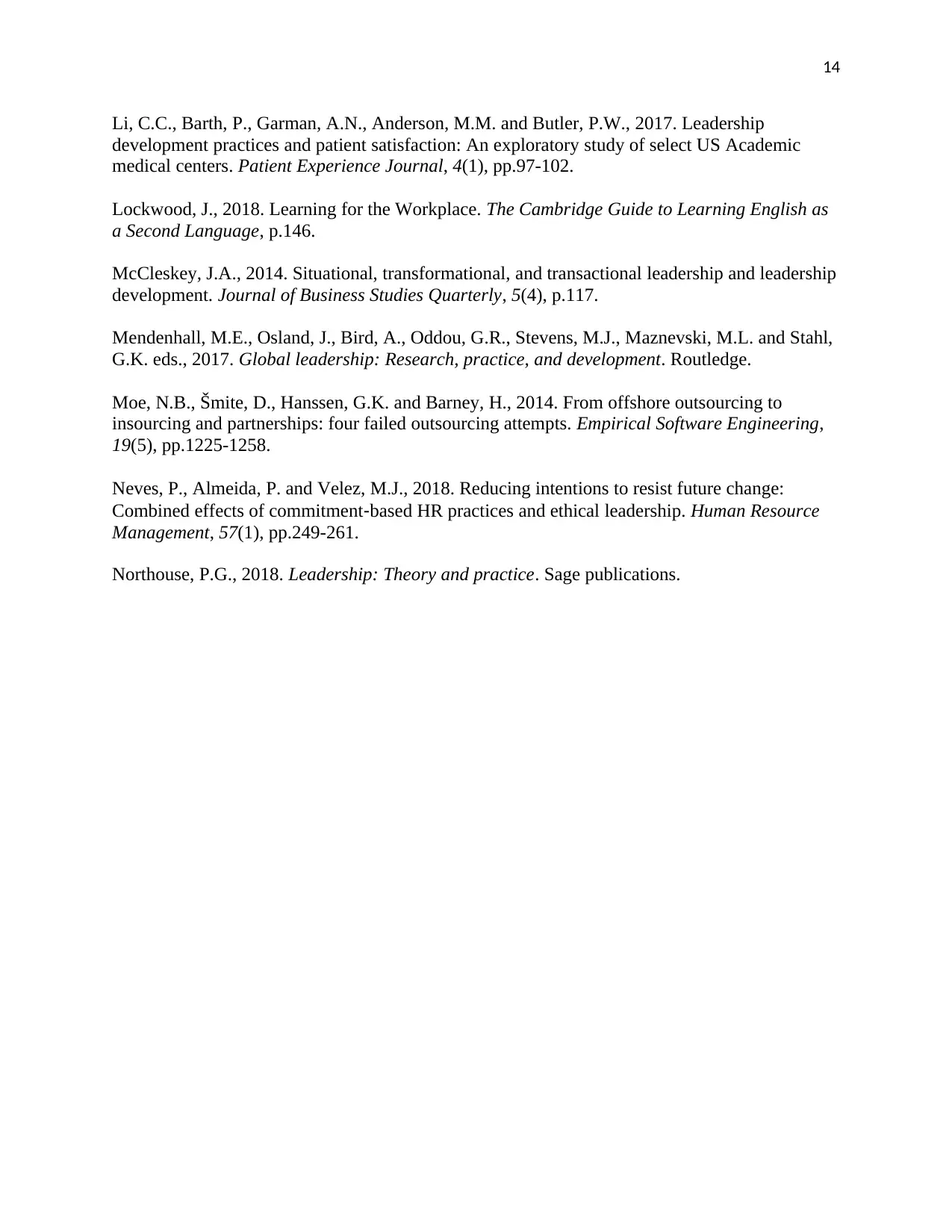
14
Li, C.C., Barth, P., Garman, A.N., Anderson, M.M. and Butler, P.W., 2017. Leadership
development practices and patient satisfaction: An exploratory study of select US Academic
medical centers. Patient Experience Journal, 4(1), pp.97-102.
Lockwood, J., 2018. Learning for the Workplace. The Cambridge Guide to Learning English as
a Second Language, p.146.
McCleskey, J.A., 2014. Situational, transformational, and transactional leadership and leadership
development. Journal of Business Studies Quarterly, 5(4), p.117.
Mendenhall, M.E., Osland, J., Bird, A., Oddou, G.R., Stevens, M.J., Maznevski, M.L. and Stahl,
G.K. eds., 2017. Global leadership: Research, practice, and development. Routledge.
Moe, N.B., Šmite, D., Hanssen, G.K. and Barney, H., 2014. From offshore outsourcing to
insourcing and partnerships: four failed outsourcing attempts. Empirical Software Engineering,
19(5), pp.1225-1258.
Neves, P., Almeida, P. and Velez, M.J., 2018. Reducing intentions to resist future change:
Combined effects of commitment‐based HR practices and ethical leadership. Human Resource
Management, 57(1), pp.249-261.
Northouse, P.G., 2018. Leadership: Theory and practice. Sage publications.
Li, C.C., Barth, P., Garman, A.N., Anderson, M.M. and Butler, P.W., 2017. Leadership
development practices and patient satisfaction: An exploratory study of select US Academic
medical centers. Patient Experience Journal, 4(1), pp.97-102.
Lockwood, J., 2018. Learning for the Workplace. The Cambridge Guide to Learning English as
a Second Language, p.146.
McCleskey, J.A., 2014. Situational, transformational, and transactional leadership and leadership
development. Journal of Business Studies Quarterly, 5(4), p.117.
Mendenhall, M.E., Osland, J., Bird, A., Oddou, G.R., Stevens, M.J., Maznevski, M.L. and Stahl,
G.K. eds., 2017. Global leadership: Research, practice, and development. Routledge.
Moe, N.B., Šmite, D., Hanssen, G.K. and Barney, H., 2014. From offshore outsourcing to
insourcing and partnerships: four failed outsourcing attempts. Empirical Software Engineering,
19(5), pp.1225-1258.
Neves, P., Almeida, P. and Velez, M.J., 2018. Reducing intentions to resist future change:
Combined effects of commitment‐based HR practices and ethical leadership. Human Resource
Management, 57(1), pp.249-261.
Northouse, P.G., 2018. Leadership: Theory and practice. Sage publications.
1 out of 14
Your All-in-One AI-Powered Toolkit for Academic Success.
+13062052269
info@desklib.com
Available 24*7 on WhatsApp / Email
![[object Object]](/_next/static/media/star-bottom.7253800d.svg)
Unlock your academic potential
© 2024 | Zucol Services PVT LTD | All rights reserved.


